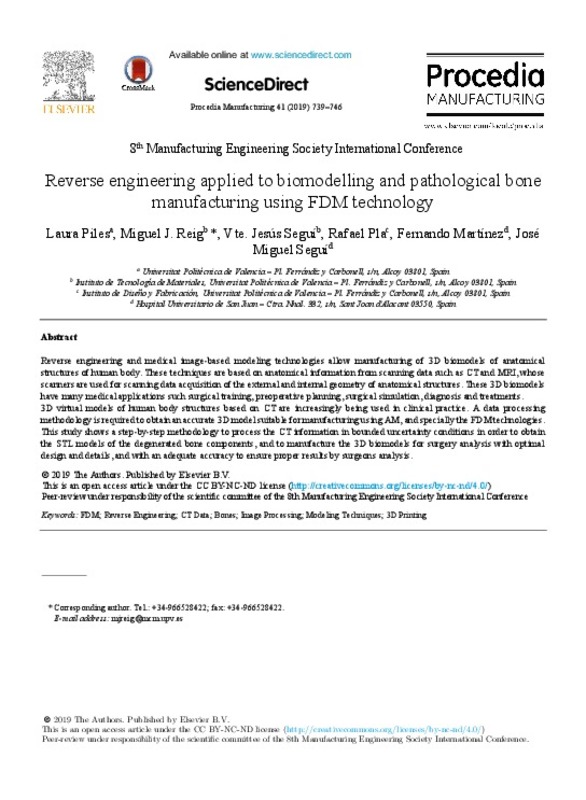JavaScript is disabled for your browser. Some features of this site may not work without it.
Buscar en RiuNet
Listar
Mi cuenta
Estadísticas
Ayuda RiuNet
Admin. UPV
Reverse engineering applied to biomodelling and pathological bone manufacturing using FDM technology
Mostrar el registro sencillo del ítem
Ficheros en el ítem
| dc.contributor.author | Laura Piles
|
es_ES |
| dc.contributor.author | Miguel J. Reig
|
es_ES |
| dc.contributor.author | Vte. Jesús Seguí
|
es_ES |
| dc.contributor.author | Rafael Pla
|
es_ES |
| dc.contributor.author | Fernando Martínez
|
es_ES |
| dc.contributor.author | José Miguel Seguí
|
es_ES |
| dc.date.accessioned | 2021-01-28T04:31:26Z | |
| dc.date.available | 2021-01-28T04:31:26Z | |
| dc.date.issued | 2019 | es_ES |
| dc.identifier.uri | http://hdl.handle.net/10251/160074 | |
| dc.description.abstract | [EN] Reverse engineering and medical image-based modeling technologies allow manufacturing of 3D biomodels of anatomical structures of human body. These techniques are based on anatomical information from scanning data such as CT and MRI, whose scanners are used for scanning data acquisition of the external and internal geometry of anatomical structures. These 3D biomodels have many medical applications such surgical training, preoperative planning, surgical simulation, diagnosis and treatments. 3D virtual models of human body structures based on CT are increasingly being used in clinical practice. A data processing methodology is required to obtain an accurate 3D model suitable for manufacturing using AM, and specially the FDM technologies. This study shows a step-by-step methodology to process the CT information in bounded uncertainty conditions in order to obtain the STL models of the degenerated bone components, and to manufacture the 3D biomodels for surgery analysis with optimal design and details, and with an adequate accuracy to ensure proper results by surgeons analysis. | es_ES |
| dc.description.sponsorship | The authors wish to acknowledge the support of Ms. Jerica Risent and Mr. Joan Ortiz of Ford Motor Company for his assistance in the scanning of printed models. This work was supported by the Polisabio Funding (UPV-Fisabio 2017) | es_ES |
| dc.language | Inglés | es_ES |
| dc.publisher | Elsevier | es_ES |
| dc.relation.ispartof | Procedia Manufacturing | es_ES |
| dc.rights | Reconocimiento - No comercial - Sin obra derivada (by-nc-nd) | es_ES |
| dc.subject | FDM | es_ES |
| dc.subject | Reverse Engineering | es_ES |
| dc.subject | CT Data | es_ES |
| dc.subject | Bones | es_ES |
| dc.subject | Image Processing | es_ES |
| dc.subject | Modeling Techniques | es_ES |
| dc.subject | 3D Printing | es_ES |
| dc.subject.classification | INGENIERIA MECANICA | es_ES |
| dc.subject.classification | INGENIERIA DE LOS PROCESOS DE FABRICACION | es_ES |
| dc.title | Reverse engineering applied to biomodelling and pathological bone manufacturing using FDM technology | es_ES |
| dc.type | Artículo | es_ES |
| dc.type | Comunicación en congreso | es_ES |
| dc.identifier.doi | 10.1016/j.promfg.2019.09.065 | es_ES |
| dc.relation.projectID | info:eu-repo/grantAgreement/UPV//UPV-FISABIO-2017-003-1606/ | es_ES |
| dc.rights.accessRights | Abierto | es_ES |
| dc.contributor.affiliation | Universitat Politècnica de València. Departamento de Ingeniería Mecánica y de Materiales - Departament d'Enginyeria Mecànica i de Materials | es_ES |
| dc.description.bibliographicCitation | Laura Piles; Miguel J. Reig; Vte. Jesús Seguí; Rafael Pla; Fernando Martínez; José Miguel Seguí (2019). Reverse engineering applied to biomodelling and pathological bone manufacturing using FDM technology. Procedia Manufacturing. 41:739-746. https://doi.org/10.1016/j.promfg.2019.09.065 | es_ES |
| dc.description.accrualMethod | S | es_ES |
| dc.relation.conferencename | 8th Manufacturing Engineering Society International Conference (MESIC 2019) | es_ES |
| dc.relation.conferencedate | Junio 19-21,2019 | es_ES |
| dc.relation.conferenceplace | Madrid, España | es_ES |
| dc.relation.publisherversion | https://doi.org/10.1016/j.promfg.2019.09.065 | es_ES |
| dc.description.upvformatpinicio | 739 | es_ES |
| dc.description.upvformatpfin | 746 | es_ES |
| dc.type.version | info:eu-repo/semantics/publishedVersion | es_ES |
| dc.description.volume | 41 | es_ES |
| dc.identifier.eissn | 2351-9789 | es_ES |
| dc.relation.pasarela | S\405298 | es_ES |
| dc.contributor.funder | Universitat Politècnica de València | es_ES |
| dc.description.references | Van Eijnatten, M., Berger, F. H., de Graaf, P., Koivisto, J., Forouzanfar, T., & Wolff, J. (2017). Influence of CT parameters on STL model accuracy. Rapid Prototyping Journal, 23(4), 678-685. doi:10.1108/rpj-07-2015-0092 | es_ES |
| dc.description.references | Lalone, E. A., Willing, R. T., Shannon, H. L., King, G. J. W., & Johnson, J. A. (2015). Accuracy assessment of 3D bone reconstructions using CT: an intro comparison. Medical Engineering & Physics, 37(8), 729-738. doi:10.1016/j.medengphy.2015.04.010 | es_ES |
| dc.description.references | Stull, K. E., Tise, M. L., Ali, Z., & Fowler, D. R. (2014). Accuracy and reliability of measurements obtained from computed tomography 3D volume rendered images. Forensic Science International, 238, 133-140. doi:10.1016/j.forsciint.2014.03.005 | es_ES |
| dc.description.references | Van Eijnatten, M., van Dijk, R., Dobbe, J., Streekstra, G., Koivisto, J., & Wolff, J. (2018). CT image segmentation methods for bone used in medical additive manufacturing. Medical Engineering & Physics, 51, 6-16. doi:10.1016/j.medengphy.2017.10.008 | es_ES |
| dc.description.references | Javaid, M., & Haleem, A. (2018). Additive manufacturing applications in medical cases: A literature based review. Alexandria Journal of Medicine, 54(4), 411-422. doi:10.1016/j.ajme.2017.09.003 | es_ES |
| dc.description.references | D.V.C. Stoffelen, K. Eraly, P. Debeer, The use of 3D printing technology in reconstruction of a severe glenoid defect: a case report with 2.5 years of follow-up, Journal of Shoulder Elbow Surgery, 24 (2015) e218-e222 | es_ES |








